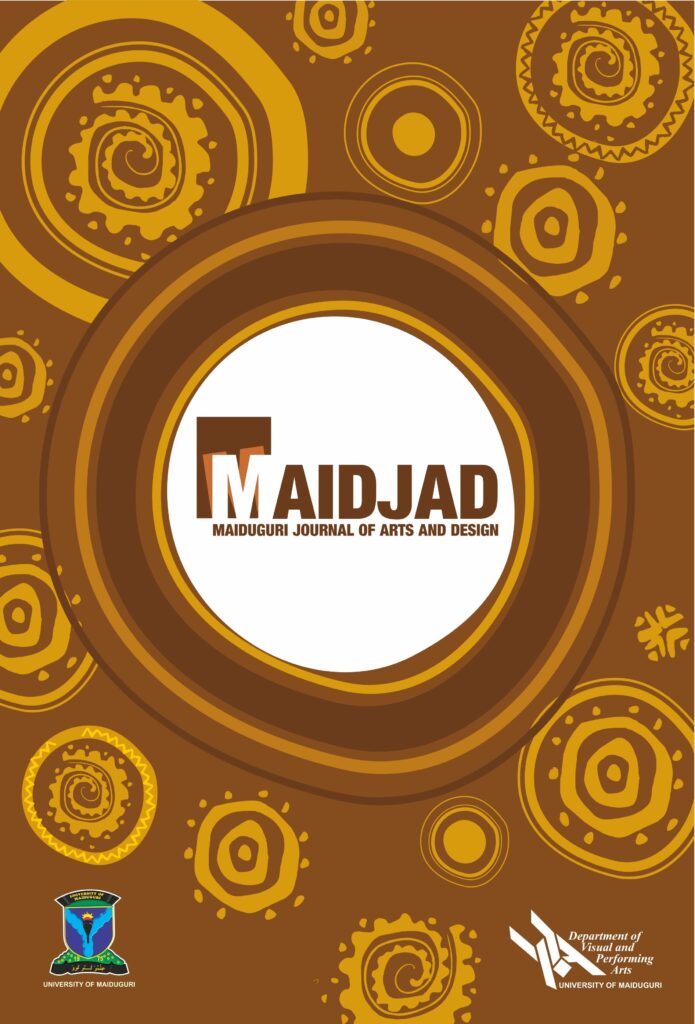
FOREWORD
The Maiduguri Journal of Arts and Design (MAIDJAD), was first published in March 2017. In the maiden issue, 30 papers were published. Volume 1 was published in October of the same year with 27 papers. Volume 2 published also in October 2017, had 31 papers while Volume 3, published in May 2018, had 44 papers. This present volume, Volume 4, has 33 papers. It is an indication that MAIDJAD has remained consistent in the past three years and has continued to attract interest from many art and design scholars. This interest is further enriched by the variety of papers and the national spread of their contributors. Readers, who had ever been engaged in journal publication, would appreciate the trouble it takes to maintain consistency. I recall when our National Gallery of Art first published its journal, Uso, in 1995, in the euphoria of a new publication, it made it a point to state in its editorial comment that it was never going to publish in “gasps and spasms” as The Eye Society did. Despite its privileged position at the time, it could not escape puffing and panting into its present comatose state.
In this edition of MAIDJAD, it is exciting to see contributors strutting their specializations. Those in the studio, report on their experiences and experiments while others in the theories, set out to debunk or reestablish existing canons, concepts and theories. The desire to document African dance through the development of comprehensible notations, seems to me groundbreaking. Would the reader like to be called “Mama Actor” or “Papa Dramatist”? Be guided by the paper on the misconception about Theatre scholarship. A particularly topical issue is raised by the paper, which laments the drawbacks encountered in the practice of Art History in Nigeria. It reads like a motivational speech to secondary school kids but it provokes excitement nonetheless. What qualifies one as a professional Art Historian? I remember being warned by a senior colleague, despite my two degrees in Art History, a Master’s and a PhD, not to pander to the profession of Art History! I suppose it is the type of issue which led to the sudden departure of the legendary Kojo Fosu from the Department of Fine Art, Ahmadu Bello University, Zaria in the 1980s. The issue is definitely not limited to Art History.
There is always room for improvement in journal publication. Only one or two Professors, for instance, published in this edition and it appears that their names were added by their co-authors. Regrettably, only those seeking promotion continue to agitate to publish. The editors of MAIDJAD should therefore, strive to encourage submission of papers not only from members of institutions of higher learning but also from established artists and designers elsewhere in order to further improve the quality of the journal.
Professor Jacob Jari
January, 2019
Get individual articles of all authors below.
INTEGRATING ART, SCIENCE AND TECHNOLOGY IN EDUCATION
MBAHI, A. A. Professor of Art Education
TAPESTRY DESIGNS: A FOCUS ON MARY DALYOP ZANG’S SELECTED WORKS
JAJI, Muyideen Adio/ ZANG, Mary Dalyop
AN ANALYSIS OF FUNDAMENTAL FUNCTIONS OF THEATRE MANAGEMENT/MANAGERS
DIAKPOMRERE, Vincent/BARDI, John Ndubuisi
NWARU, Christian
THE IMPLICATIONS OF COMPUTER IN ART EDUCATION: PROBLEMS AND PROSPECTS
OHAMBELE, James Chimezie
IMPORTANCE OF PUBLICITY AND MARKETING IN THEATRE MANAGEMENT IN SELECT NIGERIAN UNIVERSITIES
BARDI, John Ndubuisi/ DIAKPOMRERE, Vincent
A COMPARISON OF GROTOWSKI, BRECHT AND CONTEMPORARY NIGERIAN THEATRE PRACTICE
OLUSEGUN, Kayode Abodunrin
AN OVERVIEW OF VIRTUAL EXHIBITION AND THE GLOBALIZATION OF ART SHOWS
OSAIGBOVO, Felix Onaiwu
CREATING FOR THE INTERNET: NEW DIRECTION FOR FILM DISTRIBUTION AND EXHIBITION
OSHODI, Oluwadamilola O.
BOYI, John Mallam
VISUAL INTERPRETATION OF FORMS AND ELEMENTS IN KWAGH-HIR ANIMAL MASQURADES
USMAN, Musiliat Ozavize/AVAV, Joshua Aondona
AN ANALYSIS OF GENDER AND POLITICAL PARTICIPATION ISSUES
IN SALAMI-AGUNLOYE’S MORE THAN DANCING
AGBOOLA, Michael Olanrewaju
REFRACTORY PROPERTIES OF GETSO AND DANBAKOSHI KAOLIN DEPOSITS FOR INSULATION FIREBRICKS IN NIGERIA
SHAAIBU, S./ SADIQ, Y. O.
OLA-KOYI, S. Joseph Bankola
THEATRE SCHOLARSHIP AND THE AGONY OF MISCONCEPTION
AND MISINTERPRETATION: A READING OF JOE DE CRAFT’S SONS
AND DAUGHTERS
EKWEARIRI, Chidi
OPTIMIZATION OF AFFORDABLE ARTY TEACHING AND LEARNING MATERIALS/RESOURCES
OTOBO, Audu O. A. / IDAHOSA, Harrison
AN ANALYTICAL NARRATIVE ON PAINTERS EVOLUTIONARY APPROACH TO THE HUMAN FIGURE
ACHUGWO, Stephen Chinedu
DEMOCRACY AND SOCIO-POLITICAL DISCOURSE: SALIENT THEMES FOR THE CONTEMPORARY NIGERIAN PAINTER
AGAKU, S. Amos
DRAWING CONCEPTS: A VISUAL EXPLORATION OF FISH FORMS
LAMIDI Lasisi Abdul
ISSUES AFFECTING PROFFESSIONALISM IN THE PRACTICE OF
ART HISTPRIOGRAPHY IN NIGERIA
SAMUEL, Caleb
WASTE TO WEALTH: FABRICATION OF FOOT WEAR FROM JACQUARD HEAD TIES USED IN CONTEMPORARY FASHION
CHUDI-DURU, Chika Chinyeogwa
A COMPARATIVE APPRAISAL AND ELEVATION OF SELECTED MARKET DISPLAYS AS UNCONSCIOUS ART INSTALLATIONS
DUNIYA, G. Gambo/ ADEWUMI, C. Kehinde
HARUNA, Naomi Andrew/ SALIBA, James
SHALLANGWA, Zainab Musa/SALIBA, James
UPPING THE ANTE: POPULAR THEATRE AS A MEDIUM FOR INCREASING VOTER AWARENES
UKUMA, Teryila Shadrach
HAUSA DRAMA, MUSIC AND PERFORMANCE(S) AS MEDIUM OF BROADCAST MEDIA ADVERTISEMENTS IN HAUSA LANGUAGE
ABDULMUMIN, S.A.
THE HISTORY AND CULTURAL FESTIVALS OF BURA PEOPLE IN HAWUL
SHEHU, Samaila Simon/SAIDU, Amina Ramat/SHEHU, Sadiq Adeiza
DESIGN AND CONSTRUCTION OF WATER FILTER CANDLE
GADZAMA, Ruth Mataba
A VISUAL DIALOGUE BETWEEN LINES AND FLORAL MOTIFS IN PAINTING
NADAMA, Mustapha Garba
CHANGE AND CONTINUITY IN EBIRA EKUECHI FESTIVAL
SHEHU, Sadiq Adeiza / SHEHU, Samaila Simon/ AJI, Lawan
AN IMPEDIMENT TO CULTURALLY INFLUENCED IDENTITY PROCESSING
OF GRASPABLE OBJECTS: A TYPOGRAPHIC INTERPRETATION
OTOBO, Audu Omar Ahmed / WATILA, Musa Mamman, / JAMES, Lucky
AMSAMI Bello Usman / SALEH, Hamsatu
EMERIEWEN, Kingsley Osevwiyo / OMATSEYE, Bridget. O. J.
LAWAL, Lamidi Aduozava